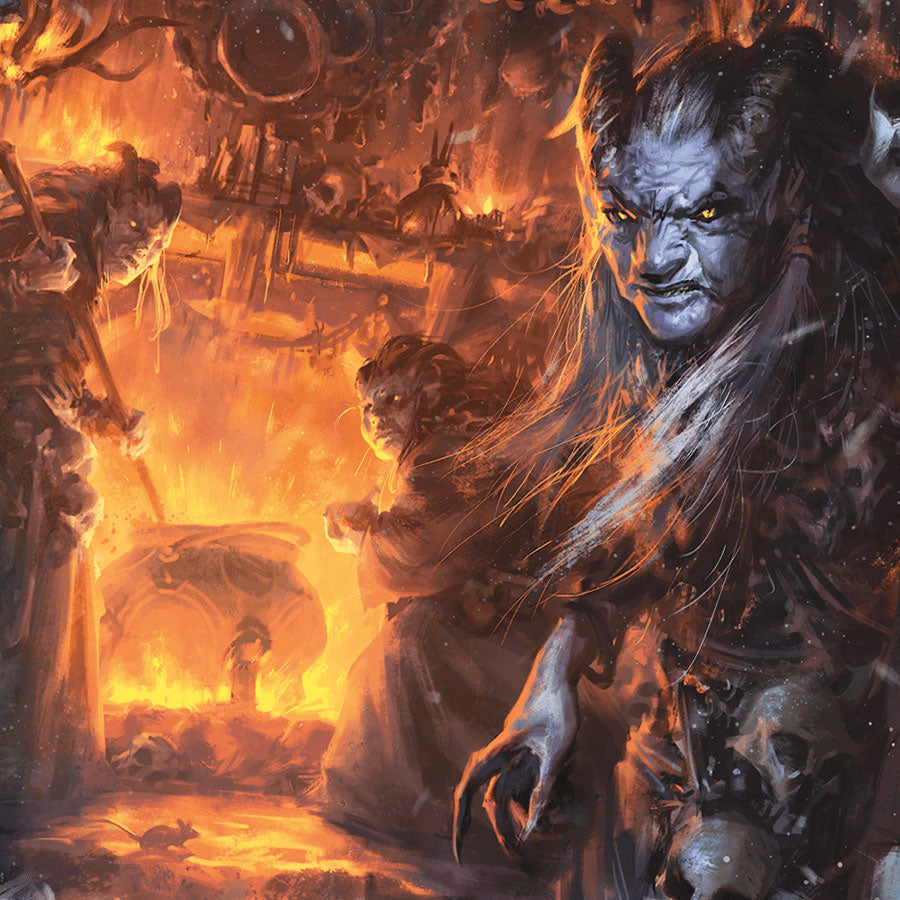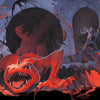How to Run an Evil D&D Campaign

Okay, today we’re going to talk about how to run an EVIL D&D campaign. And we’re going to get very practical, not just some high-level theory you’re unsure how to implement at your game table. Specifically, we’re going to talk about how to STRUCTURE and DRIVE an evil campaign, which is something I don’t see talked about very much.
Also, a lot of the time, when people say “evil campaign,” what they are actually talking about is a normal campaign where the characters are just murder hobos. Well, that’s not an evil campaign. That’s a normal campaign that has player issues. So, today we’re going to be talking about how to run an actual, legitimate, EVIL CAMPAIGN, and I have four main points for you.
Watch or listen to this article by clicking the video below.
Code of Conduct
Just because it’s an evil campaign doesn’t mean our norms of behavior are thrown out the window. The PCs are evil, not the PLAYERS. I mean, hopefully… There are still guidelines that need to be followed, lest your awesome evil campaign implode upon itself and go down in a wreck of burning flames after the second game session or so, and then your group of friends disbands with each swearing eternal hatred for each other.
First: Work Together
D&D is a group game. Players must agree that their characters are still going to work together, similar to a good campaign, even though they are evil. Bad guys work together all the time in real life. Criminal organizations are both a reality in our world and are a staple in most games. In fact, it’s quite likely that you have created or use criminal organizations in your other campaigns!
This guideline ensures that the dungeon master is still just running ONE game, not several, which is what happens if the individual PCs split up and pursue their own evil goals. This isn’t much different than what happens if, in a good campaign, the characters all split up and pursue their own individual goals. That’s miserable, most of the players’ time is spent on their phones waiting for their chance to play, meanwhile, the game master has to do four to six times as much prep work. As the game master, do you really want to run FOUR TO SIX games at the same time if the PCs are not working together as a group? And do your players want to play in one out of the four to six games that you’re running every game session? I know I would take playing and running ONE game for four to six people every couple of weeks.
Second: No PvP or Backstabbing
For some reason, players playing evil characters somehow think this is what they should do… no idea why because it makes no sense, but this is what can happen: describe a player/PC going all power drunk with evil and attacking and backstabbing and murderizing everyone all around them and how it ends very badly for them. Good bad guys in real life don’t do this…because they know it doesn’t work in the long term. They need to work together if they want to accomplish their goals.
In real life, an eventual backstabbing is on the table and perhaps probable for bad guys who are successful. When you’re dealing with bad people, you’re only as safe as you are useful, so once that has passed, you’re close behind. However, this needs to be off the table for a tabletop game. Why?
Well, the truth is that PvP rarely—if ever—works out. Now, I know that there are some groups that allow PvP, and it works fine for them. More power to them! I am not trying to criticize their games or say they shouldn’t play how they want to play. However, for the VAST majority of groups, PvP simply doesn’t work out. People get attached to their characters and the game isn’t balanced around PvP. Also, quite frankly, most adults (let alone kids or teenagers) lack the maturity to properly handle PvP and it can lead to tension, drama, and even the end of friendships.
Given the risks, I just don’t think it’s worth it to allow PvP, even in an evil campaign.
Third: Set Limits to the Evil
Discuss that the group needs to talk about what in-game behavior is and isn’t allowed. Just because the PCs are evil doesn’t mean they should be allowed to do anything. This needs to be an open and frank conversation between you and your players. Everyone at the table needs to understand that these limits aren’t going to be tested or trifled with. That doesn’t mean everyone necessarily needs to agree with all the limits, but the most important thing to remember is that the people in your group are not evil; what one person is okay with might be something that another will never tolerate.
There is a chance that, when you’re discussing this, your players’ comfort zones are fundamentally incompatible with each other in this context (even if you’ve played good campaigns with no issue in the past!). This may be a sign that your group just isn’t right for an evil campaign—and that is OKAY!
Do These Steal Player Agency?
They kind of do, but for good reason! If your goal is to have a fun game where everyone enjoys themselves and things don’t implode, then it’s necessary to set rules and limits to an evil campaign. If that’s “stealing agency,” then so be it. And tell your players that if they don’t like it, they are welcome to play in someone else’s evil campaign. And then when it ends after a few sessions because everyone is pissed at each other, they are more than welcome to come back to your game and carry on like nothing happened. Sometimes people have to experience the poor alternative to understand the necessity of rules in a civilized society.
Character Driven Campaign
Evil campaigns are quite different from standard campaigns. Standard campaigns TEND to be less driven by the characters’ goals and desires, and more by whatever the dungeon master decides their bad guys are up to. In a standard campaign, characters often REACT to what the bad guys are doing. It’s just the nature of how the game is usually designed.
So, since an evil campaign flips around who the good and bad guys are, who reacts to whom is also flipped. Instead of the dungeon master deciding what the plotline, situation, or story will be in the campaign, the PLAYERS need to decide what the goals and motivations of their bad guys are. Why? Because bad guys in a standard game are the shakers and movers – they start stuff first, and then the good guys step in to try to stop them. So, the players must take on that role to instigate and do bad stuff. So, what are they trying to accomplish in the world? What do they want to do?
Well, that’s up to your group!
So, the first step in an evil campaign, then, is for the players to decide what their group’s evil ambition and goal is. And then, the game master is going to design a campaign based on that. This is why I say that an evil campaign is CHARACTER DRIVEN. Now, someone might say that you could have a good campaign that is character-driven, too, and you’re right. I’m not saying you can’t. What I’m saying is that for an evil campaign, it's practically a requirement. How to implement this in a practical way: Session zero. Use your session 0 for not only establishing everything we’ve already talked about and creating characters but also deciding what that evil goal and ambition is. It doesn’t need to be set in stone for the entire campaign, but it needs to be something the group commits to pursuing. Otherwise, good luck preparing!
And then the GM takes that information, goes off, and does their campaign planning based on it.
Just remember: remain flexible! The outcomes of adventures and actions might shift what the players decide to do. Only plan out one adventure at a time, and be willing to shift your campaign planning as needed.
Have your good guys react! Once the player’s characters start doing bad stuff, the good guys are going to learn about it and step in and interfere. Bake that into your campaign. It might feel like you’re constantly trying to thwart the cool stuff your players are trying to do, and you kind of are. This is something you’re going to need to get buy-in from your players on so they don’t feel like it’s turning into a game master vs player situation.
How to Structure an Evil Campaign
There are two basic ways you can structure an evil campaign. 1st, the same way you would structure a good campaign, and 2nd, do the opposite. What does that mean?
In a typical good campaign’s structure, the party goes on adventures to achieve their goals and stop the bad guys.
Since the campaign is character-driven, the players will determine what they are trying to accomplish, and then the dungeon master will design an adventure around that idea. This is similar to a West Marches campaign if you’re familiar with those.
The game master still has the freedom to design the SPECIFICS of the adventure. The characters should only state their HIGH-LEVEL GOAL: infiltrate the manor of a noble that they believe might have an item or information. The GM still gets to decide the specifics of what’s in that manor, the creatures they might encounter, and all that. Remember, the players only control THEIR CHARACTERS; the GM still runs the rest of the world.
Or structure an evil campaign in reverse from a good campaign. What the heck does that mean?
Basically, the evil characters set up bases of operations where their goons further their goals, and then they need to DEFEND those bases of operations against the good guys’ incursions. For example, the characters might set up a base in a countryside villa where they can strike at the city’s nobles. They have it stocked with some hobgoblin hirelings to defend it, and then they learn that the Red Sashes might be sending a strike force against the villa. They need to get back there in time to help defend it, because their hobgoblins might not be enough. Then, you run a “defend the dungeon” scenario.
My suggestion: do a bit of both. Since the game system is set up to support adventures, the rules and mechanics probably work best for that, so perhaps standard adventures form the bulk of your campaign. Defend the dungeon scenarios might happen from time to time, but not constantly, since the rules/mechanics might not work the best for that. Furthermore, defend the dungeon scenarios are likely to turn into 100% combat game sessions, which ignore the other two pillars of play – exploration and social interaction – which are also very important to good games. You CAN design defend the dungeon scenarios that have all 3 pillars, but I think it’s more challenging to do so. Thus, I recommend a mix of these two structures when running an evil campaign.
Adversaries: the Bad (or Good) Guys
Another important point: as the GM running the “good guys” you are not limited to creatures and monsters that are good or neutral aligned. Either have reasons for evil creatures to be on the side of good or have reasons for the PCs to need to go up against evil creatures if you want to use them. The monster manuals tend not to have too many “good” creatures, so you will really be limiting yourself if you don’t use evil creatures, too, and you’ll be omitting some of the coolest monsters in the game, too!
This assumes, of course, that your players’ evil characters are going up against good creatures. Because they might not be. Evil creatures fight evil creatures all the time. So, the campaign might tend toward that direction, too. After all, even though the players’ characters are all working together doesn’t mean the rest of the evil in the world has to work with them too!
Another pitfall: only using humanoid creatures because they are typically “good” and the group is evil. This does fall into the category of what I just mentioned. Still, I give it a particular mention because it can lead to a particularly bland game if the only creatures the bad guy characters are going up against are good or neutral-aligned humanoids – humans, elves, dwarves, etc. And bland because there is little VARIETY in whom the players face in the game. Variety is king. Not having a variety will make the game bland and boring for the dungeon master. So, use all those cool creatures from the monster manuals! Just come up with creative reasons for WHY so that things make sense from a roleplaying or story perspective.
GM Resources for Your 5e Game
Of course, most games aren’t evil, they’re good! And if you need something to reduce your prep time and help you run awesome games, check out Lairs & Legends. It’s filled with page after page of professionally designed resources to bring your games to the next level.
-
Posted in
Game Master How-To Articles







